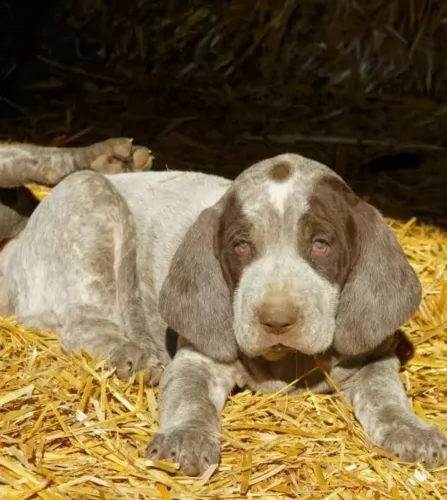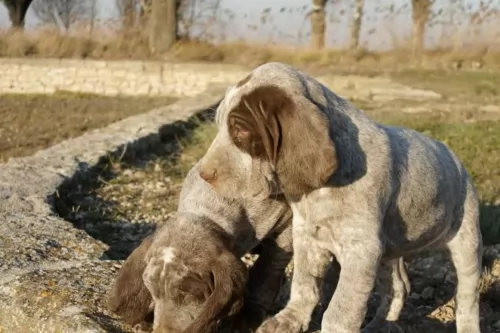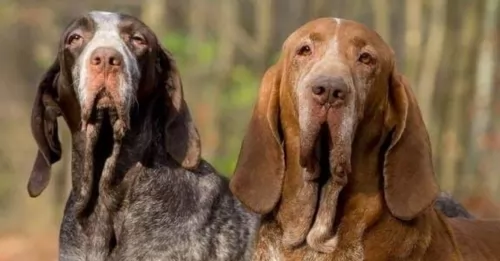 MyDogBreeds
MyDogBreeds Perdiguero de Burgos is originated from Spain but Himalayan Mastiff is originated from India. Perdiguero de Burgos may grow 7 cm / 2 inches shorter than Himalayan Mastiff. Perdiguero de Burgos may weigh 46 kg / 101 pounds lesser than Himalayan Mastiff. Both Perdiguero de Burgos and Himalayan Mastiff has almost same life span. Both Perdiguero de Burgos and Himalayan Mastiff has same litter size. Perdiguero de Burgos requires Low maintenance. But Himalayan Mastiff requires Moderate maintenance
Perdiguero de Burgos is originated from Spain but Himalayan Mastiff is originated from India. Perdiguero de Burgos may grow 7 cm / 2 inches shorter than Himalayan Mastiff. Perdiguero de Burgos may weigh 46 kg / 101 pounds lesser than Himalayan Mastiff. Both Perdiguero de Burgos and Himalayan Mastiff has almost same life span. Both Perdiguero de Burgos and Himalayan Mastiff has same litter size. Perdiguero de Burgos requires Low maintenance. But Himalayan Mastiff requires Moderate maintenance
 The Iberian Peninsula is thought to be the place of origin for many of the pointing breeds of Europe, and the Perdiguero de Burgos hails from Spain. Known as the Spanish Pointer, the dog has contributed to the development of other pointer breeds.
The Iberian Peninsula is thought to be the place of origin for many of the pointing breeds of Europe, and the Perdiguero de Burgos hails from Spain. Known as the Spanish Pointer, the dog has contributed to the development of other pointer breeds.
The dog has been around since the 1500s and believed to be a descendent of the Perdiguero Navarro and the Sabueso Español.
Today's Perdiguero de Burgos is smaller and lighter so as to make it into a better bird-hunting dog.
The Perdiguero de Burgos has always been used to hunt deer but today it is used as a pointer of smaller animals and birds.
 The Himalayan Mastiff or Tibetan Mastiff is an ancient breed. Bred to be guardians of the flock, they could take care of leopards and wolves or anything else that tied to hurt the flock. The Himalaya Mastiff is found in the Himalayan area of Tibet. They are descendants of the Tibetan dogs that developed almost any Mastiff or Molosser on earth. They may have been in the mountains since the early 1100 BC. and have been fairly isolated. It was in this isolation that the Himalayan Mastiff developed.
The Himalayan Mastiff or Tibetan Mastiff is an ancient breed. Bred to be guardians of the flock, they could take care of leopards and wolves or anything else that tied to hurt the flock. The Himalaya Mastiff is found in the Himalayan area of Tibet. They are descendants of the Tibetan dogs that developed almost any Mastiff or Molosser on earth. They may have been in the mountains since the early 1100 BC. and have been fairly isolated. It was in this isolation that the Himalayan Mastiff developed.
Their function at that time was mostly to guard property. In some circumstances an entire village is guarded by one dog. It was also during this period that the breed was taught to be aggressive by tying them up as puppies. They guarded families while the men moved the village flock higher up in the mountains. They stayed in isolation until the mid-1800’s when the Queen of England was given a Himalayan Mastiff. For thousands of years, this dog was a nomad.
Soon the breed was being exported to England. A standard was developed, and the British began to breed them. Next, they were exported to Nepal, Afghanistan, India and the United States. They are rare in Tibet these days but more popular than ever in England and the United States. The first American Himalaya Tibetan Mastiff Association came into being in 1974 and in 2006 it was recognized by the AKC.
Today in the West, the Himalayan is a domesticated, family dog. It hardly fits in an apartment of course. These new western Himalayan Mastiffs are more easy- going than the Tibetan ones, but they are still wary of strangers and somewhat aloof. They are also still very protective and nocturnal. They are smart, independent and stubborn. They are not easy to train but socialization and obedience training is essential.
A study done in 2011 showed that it is very likely that many large breed dogs were descended from this Mastiff. This includes the St. Bernard, the Rottweiler, Bernese Mountain Dog and the Great Pyrenees. Later studies showed that the Mastiff’s ability to survive in the rare air of the Himalayans was due to interbreeding with Tibetan wolves in ancient, prehistoric times. Now they are competing in the Westminster Kennel Club Dog Show.
 The Perdiguero de Burgos is a large dog with straight, strong legs and a strong, musculr body. He stands at between 52 - 64 cm and weighs between 22 - 32 kg.
The Perdiguero de Burgos is a large dog with straight, strong legs and a strong, musculr body. He stands at between 52 - 64 cm and weighs between 22 - 32 kg.
The short, smooth coat is white and liver and the coat is heavily flecked or speckled. The ears are Long and floppy, the nose dark brown, the eyes dark hazel and the tail long and fairly slender. The tail has always generally been docked.
The chest is deep, it has a strong, square shaped head with the muzzle being long and quite broad. This dog isn’t recommended for life in the city as they are active dogs requiring a lot of open spaces.
These are wonderfully calm dogs, being gentle and intelligent and with a quite, confident expression to them. Even on the hunt these gun dogs are calm and steady. He is obedient and intelligent, easy to train and patient with children and other dogs.
Training and socialization of this excellent dog simply makes him even more obedient, amicable, Loving and loyal, making him a splendid pet.
 The Himalayan Mastiff is a giant, massive dog longer than it is tall. The breed has a heavy, broad head and square muzzle. They have black noses, a level bite and almond shaped, slanted, deep set eyes. They are brown, and the ears hang close to the head. They are heavy, muscular and sturdy. They have a feathered tail curving over their back. With a heavy, thick double coat and mane they resemble a lion at times. The coat can be brown, black, and gray-blue with gold or tan markings. These are impressive and noble dogs, athletic, with cat like feet. They are agile and light on their feet.
The Himalayan Mastiff is a giant, massive dog longer than it is tall. The breed has a heavy, broad head and square muzzle. They have black noses, a level bite and almond shaped, slanted, deep set eyes. They are brown, and the ears hang close to the head. They are heavy, muscular and sturdy. They have a feathered tail curving over their back. With a heavy, thick double coat and mane they resemble a lion at times. The coat can be brown, black, and gray-blue with gold or tan markings. These are impressive and noble dogs, athletic, with cat like feet. They are agile and light on their feet.
According to some breeders there are two different kinds or types of Himalayan Mastiff. These are the Tsang-khyi or the monastery mastiff type and the Do-khyi or the nomad mastiff type. The monastery is a heavier, taller dog who face is very wrinkled while the nomad is a leaner dog with less facial wrinkles. In any litter there can be both kinds. The kind of work that was given to each dog was dependent on their type. The Monastery kind is given stationary jobs and the nomad kind got the active jobs.
 Your Perdiguero de Burgos is such an amicable dog, making a splendid family pet. He can sometimes be a little reserved but he is never aggressive.
Your Perdiguero de Burgos is such an amicable dog, making a splendid family pet. He can sometimes be a little reserved but he is never aggressive.
He can be stubborn but he is intelligent and responds well to training and socialization. He is lively, playful, energetic, calm and loving and he will be willing to join you when you go out jogging or riding your bicycle.
When it comes to grooming he is also pretty low maintenance, so you can see that when it comes to choosing a fantastic family pet, this easy-going, calm dog should be a top consideration.
 All dogs can develop health problems, and with the Perdiguero de Burgos you will need to be made aware of some of the common heath problems there are -
All dogs can develop health problems, and with the Perdiguero de Burgos you will need to be made aware of some of the common heath problems there are -
Hip dysplasia is a common skeletal disease where the dog’s hip joints don’t develop properly and the hips partially dislocate. It makes it very painful for the dog to get around. Hip dysplasia is a genetic condition, although diet and environmental factors can play a big part too. Rapid weight gain can also contribute to hip dysplasia as the extra weight puts strain on the joints.
This is caused by inflammation of the thyroid gland. Thyroid cancer can also cause hypothyroidism, and it occurs more often in large breed dogs. A common sign of low thyroid function in dogs includes thinning of the hair and a dull, lifeless coat. There is also weight gain and reduced activity. Hypothyroid dogs also are inclined to have ear infections as well as skin infections. Your pet will need to get to the vet for blood tests and treatment.
Other health problems include eye problems, allergies, bloat and even epilepsy. Once you buy a puppy, it is your responsibility to protect him from some of the deadly diseases there are and take him to the vet for his puppy vaccines.
 Being a large breed of canine, the Himalayan Mastiff has some of the typical health issues of large dogs. However, they also face a serious genetic disorder as well.
Being a large breed of canine, the Himalayan Mastiff has some of the typical health issues of large dogs. However, they also face a serious genetic disorder as well.
Canine Inherited Demyelinative Neuropathy (CIDN) – a fatal disorder seen in puppies by seven weeks of age. Puppies die before they are 5 months old.
 Exercise is of critical importance to these energetic dogs. That is why it is important for them to live in a home where there is plenty of opportunity to run, swim and hike. They’re way too energetic to be confined to a tiny city property.
Exercise is of critical importance to these energetic dogs. That is why it is important for them to live in a home where there is plenty of opportunity to run, swim and hike. They’re way too energetic to be confined to a tiny city property.
The dog is an average shedder and the smooth coat of the Perdiguero de Burgos simply requires a brush-down twice a week. A rub down too with a chamois will be therapeutic for your pet and leave the coat shiny and vibrant.
Rubbing your pet down like this will give you the opportunity to feel for any unusual lumps and check for fleas and ticks. It is also your chance to check inside the dog’s ears. The ears are floppy and because the dog loves water so much, dirt, wax and moisture can be a breeding place for bacteria and painful ear infections.
If you feed your Perdiguero de Burgos a commercially manufactured dog food, make sure you choose a high quality one that has been manufactured particularly for large, energetic dogs. Some of the poor quality foods have bad ingredients in them such as colorants, preservatives and worthless, toxic fillers that can have a detrimental affect on your pets health.
Try and include some tasty homemade food into your dog’s diet too. Tasty, nutritious food such as boiled chicken, brown rice or pasta and wholesome vegetables such as sweet potato, carrots and spinach will do your pet the world of good. You can every now and then, also include some raw meat.
All a dog wants is a simple, wholesome diet like this as it ensures he doesn’t have any digestive upsets. Dogs like simplicity and consistency. Make sure your pet has a never-ending supply of fresh, cool water.
 This breed will eat less than you think they should but don’t overfeed. Puppies need a solid dry food for large dogs. You can free feed 1 cup three times per day.
This breed will eat less than you think they should but don’t overfeed. Puppies need a solid dry food for large dogs. You can free feed 1 cup three times per day.
For dogs over a year old you can free feed anywhere from two to four cups of dry food per day. Unlike many other breeds, the Himalaya Mastiff will only eat when hungry and they may not eat more than once a day. They will not overeat. The males might not eat at all when females are in season if they are around them.
They have good strength and athletic ability.
The Himalayan Mastiff needs regular, routine walks. It is important during these walks that the human leads the way, or the dog heals. Do not overwork a young Himalayan Mastiff. They need work related jobs like structured play time, walking the boundary of their territory, playing frisbee or catch. They work and play in short bursts then rest.